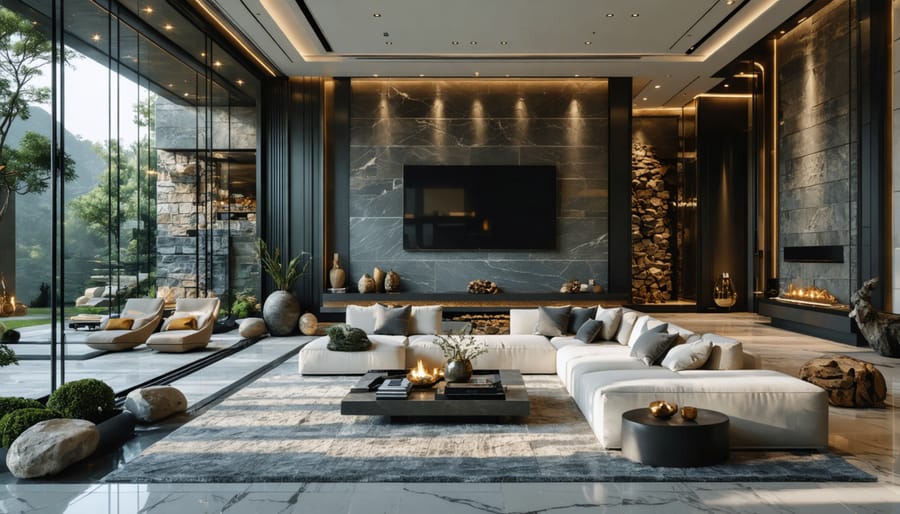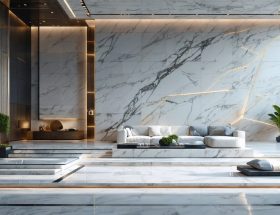Transform your interior spaces by mastering the timeless appeal of stone color palettes, a fundamental element in bringing natural elements indoors. Natural stone’s rich spectrum spans from warm beiges and golden travertines to cool grays and dramatic blacks, offering endless possibilities for sophisticated design schemes. Each stone variety presents unique veining patterns, crystalline structures, and color variations that create depth and visual interest impossible to replicate with artificial materials. Whether selecting limestone for a serene bathroom retreat, granite for a statement kitchen island, or slate for dramatic floor-to-ceiling feature walls, understanding stone color relationships enables designers to create harmonious spaces that balance bold character with timeless elegance. This guide explores essential color combinations, practical selection criteria, and expert techniques for incorporating stone’s natural beauty into contemporary design projects.
Understanding Natural Stone Color Families
Warm Stone Hues
The timeless appeal of warm stone hues draws from nature’s most comforting palette, encompassing rich beiges, luxurious browns, and earthy neutrals. These colors emerge naturally in limestone, travertine, and various sandstone varieties, creating an inviting atmosphere in any space. From creamy Jerusalem Gold to deep Emperador Brown marble, warm stone tones offer versatility in both traditional and contemporary design schemes.
Beige stones, such as Crema Marfil and Botticino marble, provide a subtle warmth that works beautifully as a foundation for any design. Their neutral undertones make them particularly adaptable, capable of harmonizing with both cool and warm design elements. Meanwhile, brown stones like Bronze Amani and Dark Emperador deliver dramatic depth and sophisticated elegance to spaces.
Earth tones in natural stone often feature complex variations and subtle veining patterns, adding visual interest beyond their base color. These organic patterns create movement and depth, particularly evident in materials like Golden Beach granite and Noce travertine. When selecting warm stone hues, consider how natural and artificial lighting will interact with the stone’s surface, as this can significantly impact its appearance throughout the day.
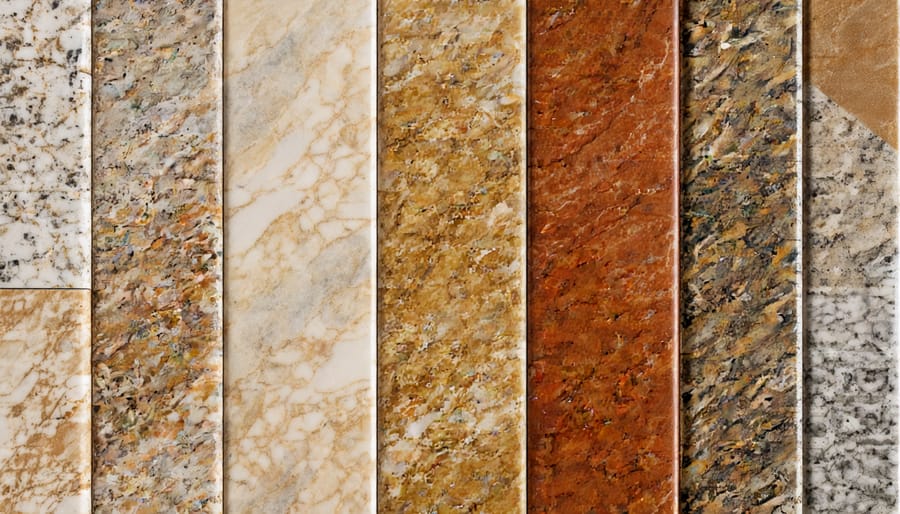
Cool Stone Tones
Cool-toned stones offer a sophisticated palette that ranges from crisp whites to deep charcoals, with various blue undertones that create a sense of tranquility and timelessness. Carrara marble exemplifies this category with its classic white background and subtle gray veining, making it a perpetual favorite for both traditional and contemporary spaces.
Bluestone varieties present a spectrum of steely grays with hints of blue, perfect for creating serene outdoor spaces and modern interior applications. Some variations display subtle tonal shifts that become more apparent when wet, adding depth and visual interest to the surface.
Gray granite options span from light silver to deep pewter, often featuring crystalline structures that catch light beautifully. These stones prove particularly versatile in commercial spaces where durability meets aesthetic appeal. White quartzite offers a bright, clean look with crystalline sparkle, while slate brings dramatic dark grays with occasional blue-black variations.
For a contemporary aesthetic, honed or leathered finishes on these cool-toned stones can enhance their natural coloring while providing practical benefits like reduced glare and improved slip resistance.
Dramatic Stone Colors
For those seeking to make a bold statement, dramatic stone colors offer unparalleled visual impact. Absolute Black granite commands attention with its deep, consistent tone, while Black Galaxy adds subtle sparkle through bronze-colored flecks. Deep red stones like Ruby Red granite and Dragon Red marble introduce passionate energy into spaces, often featuring swirling patterns that create dynamic focal points.
Distinctive stones like Blue Bahia granite showcase intense blue hues with black and white crystalline structures, while Verde Peacock granite displays a mesmerizing blend of emerald green and black. These dramatic options particularly shine in statement pieces like kitchen islands, accent walls, or grand entryways.
When working with bold stones, consider using them as centerpiece elements balanced by neutral surroundings. Their strong character can anchor a design scheme while creating lasting visual interest through their unique patterns and color depths.
Creating Color Harmony with Stone
Monochromatic Stone Schemes
Monochromatic stone schemes offer sophisticated elegance while adhering to modern stone design principles. By utilizing varying shades and textures of a single stone color, designers can create depth and visual interest without introducing contrasting hues. For example, a gray palette might combine polished Pearl Gray marble with honed Pewter limestone and textured Gray slate to achieve dimensional layering.
To successfully execute a monochromatic scheme, focus on three key elements: texture variation, shade progression, and pattern diversity. Consider using the same stone in different finishes – polished, honed, and bush-hammered – to create subtle contrasts. Incorporate stones with similar base colors but different veining patterns or mineral compositions to add natural variety.
When working with beige tones, pair smooth Crema Marfil with textured Travertine and split-face Jerusalem Gold limestone. For black schemes, combine glossy Absolute Black granite with leather-finished Black Galaxy and flamed Black basalt. These thoughtful combinations ensure visual depth while maintaining the sophistication of a single-color approach.
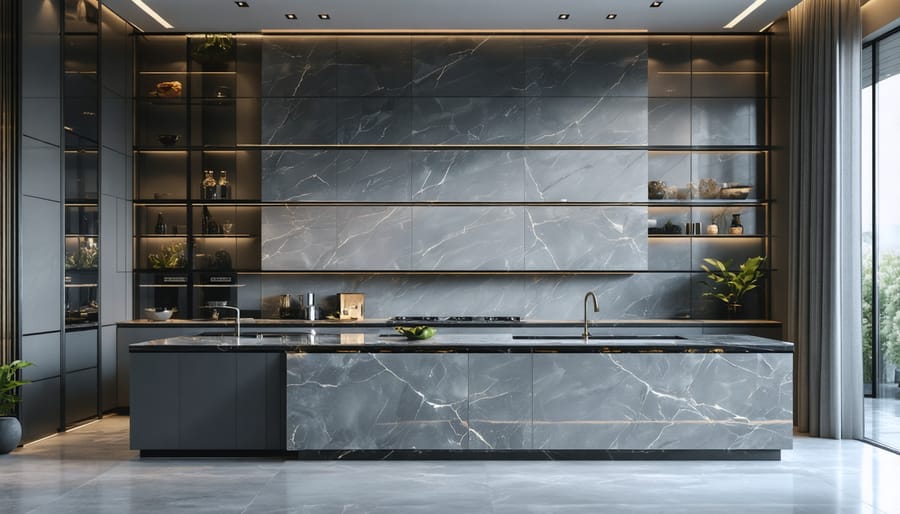
Complementary Stone Combinations
Creating impactful stone designs often relies on thoughtful color combinations that enhance the overall aesthetic appeal. When mixing stone patterns and colors, consider both complementary and contrasting relationships to achieve desired effects.
Light-colored stones like Crema Marfil marble pair exceptionally well with darker varieties such as Nero Marquina, creating a classic high-contrast look. For more subtle combinations, consider pairing stones within the same color family but with varying intensities, such as Emperador Light with Emperador Dark brown marble.
Beige travertine works harmoniously with earth-toned granites, while cool gray stones complement blue-toned varieties like Azul Bahia. When working with statement pieces, such as dramatic blue sodalite or green serpentine, pair them with neutral stones that allow the featured material to shine.
For contemporary spaces, monochromatic combinations using different textures of the same stone create sophisticated depth. Traditional designs often benefit from complementary stone colors, such as gold-veined marble with cream limestone accents.
Remember that lighting conditions significantly impact how stone colors interact. Natural daylight brings out true stone colors, while artificial lighting can alter their appearance. Always view potential combinations under the intended lighting conditions before making final selections.
Accent Stone Selection
Accent stones serve as striking focal points in any design scheme, adding drama and visual interest to your space. When selecting bold accent stones, consider pieces with rich veining, dramatic patterns, or intense coloration that can create powerful visual statements. Deep burgundy granites, electric blue sodalite, or vibrant green malachite can transform an otherwise neutral space into a captivating environment.
For maximum impact, limit accent stones to 20-30% of your overall stone composition. These statement pieces work best when balanced with more subdued stones that complement rather than compete with the focal point. Consider using bold stones for feature walls, kitchen islands, or decorative inlays where they can command attention without overwhelming the space.
Remember that lighting plays a crucial role in how accent stones appear. Natural light can enhance the depth and character of colored stones, while artificial lighting can be strategically placed to highlight specific features. Before making a final selection, always view accent stone samples under the same lighting conditions that will be present in your space.
Popular accent stone choices include exotic quartzites with bold streaking, richly colored onyx, and dramatic marble varieties with distinctive veining patterns. These materials can serve as conversation pieces while elevating the overall design aesthetic.
Stone Color Applications
Interior Stone Color Schemes
Interior stone applications demand thoughtful color selection to create harmonious and impactful spaces. In kitchens, neutral stone colors like beige, gray, and white remain popular choices for countertops and backsplashes, offering timeless appeal and versatility. Warm-toned granites and quartzites in golden or cream hues can add warmth while maintaining a sophisticated appearance. For modern kitchens, dramatic black or charcoal-colored stones create striking focal points, especially when paired with light-colored cabinetry.
Bathrooms benefit from lighter stone palettes that enhance the sense of cleanliness and space. Classic white marble with gray veining continues to dominate bathroom design, offering brightness and elegance. For a spa-like atmosphere, consider blue-gray limestone or cool-toned slate. These materials can be complemented with accent walls in darker stones to add depth and visual interest.
Living spaces allow for more creative stone color combinations. Natural stone fireplaces can serve as statement pieces, with options ranging from rustic earth tones to sleek, contemporary blacks and grays. Feature walls benefit from textured stones in varied color palettes, such as stacked stone in mixed browns and tans or modern stone panels in consistent gray tones.
When selecting interior stone colors, consider the room’s lighting conditions, existing décor, and intended atmosphere. Natural light can significantly affect how stone colors appear throughout the day. For optimal results, view stone samples in the intended space under various lighting conditions before making final selections. Remember that stone colors should complement rather than compete with other design elements in the room.
Exterior Stone Color Palettes
The exterior application of natural stone demands careful consideration of color palettes that complement both architectural elements and natural surroundings. For facades, lighter-toned stones like cream limestone and buff sandstone create a welcoming appearance while effectively reflecting heat, making them popular choices in warmer climates. Gray granite and bluestone offer sophisticated alternatives that work particularly well in contemporary architectural designs.
In landscaping applications, earth-toned stones such as rustic browns, warm tans, and natural grays create seamless transitions between built and natural environments. Consider using multi-colored slate or quartzite for garden pathways and retaining walls, as these materials provide visual interest while maintaining durability. For those interested in sustainable stone options, locally-sourced materials often present beautiful weathered hues that integrate perfectly with regional landscapes.
Outdoor living spaces benefit from a balanced mix of stone colors that create both visual harmony and practical functionality. Popular combinations include warm beige travertine for pool decking paired with darker accent stones for borders, or golden-hued limestone paired with chocolate-brown granite for outdoor kitchen areas. When selecting stones for exterior applications, consider how colors will appear in natural daylight and how they might weather over time.
Regional climate also plays a crucial role in color selection. Darker stones absorb more heat, making them better suited for cooler climates, while lighter stones help maintain comfortable temperatures in sunny areas. For coastal properties, salt-resistant stones in coastal-inspired colors like sandy beiges and weathered grays prove both practical and aesthetically appropriate.
Commercial Stone Color Design
Commercial spaces demand stone color palettes that balance sophistication with durability, creating environments that leave lasting impressions while withstanding heavy foot traffic. In hospitality settings, neutral stones like beige limestone and warm travertine dominate lobbies and common areas, offering timeless elegance that appeals to diverse clientele.
High-end retail establishments often incorporate dramatic stone combinations, such as contrasting black granite with white marble, to create visual interest and reinforce brand identity. Hotels frequently utilize earth-toned stones in varying textures to craft welcoming atmospheres, while restaurants pair rich-colored stones with ambient lighting to enhance dining experiences.
Modern office buildings favor cool grays and blues in granite or quartzite for their lobbies and exterior facades, projecting professionalism while maintaining visual interest. These selections often incorporate subtle variations in tone and pattern to add depth without overwhelming the space.
Healthcare facilities typically opt for calming stone palettes featuring soft whites, creams, and pale blues to create healing environments. These choices not only contribute to patient wellbeing but also maintain cleanliness standards while providing elegant aesthetics.
When selecting commercial stone colors, designers consider factors like foot traffic patterns, maintenance requirements, and the psychological impact of color choices on visitors. Successful commercial stone applications often layer multiple stone types with complementary undertones to create cohesive, professional environments that stand the test of time.
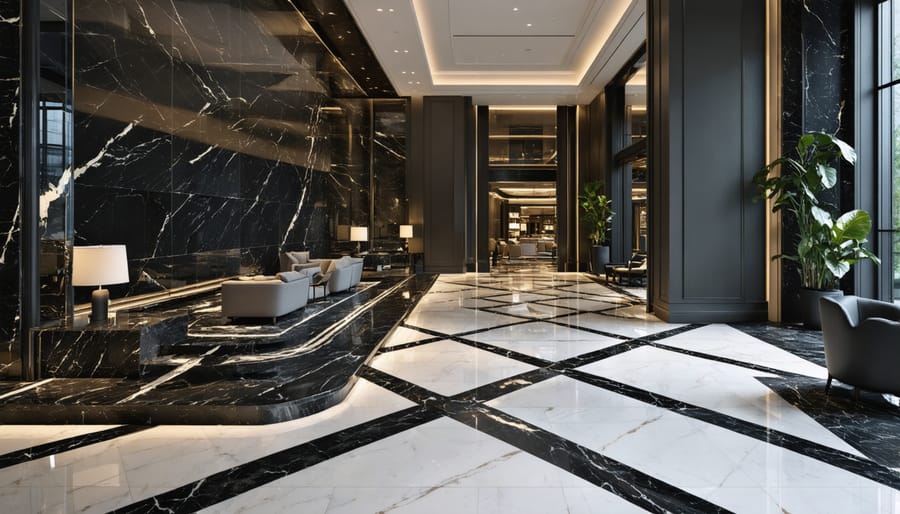
Selecting the perfect stone color palette is a journey that combines artistic vision with practical considerations. Throughout this guide, we’ve explored the rich diversity of natural stone colors, from warm earth tones to cool grays, and learned how these hues can transform spaces. The key to success lies in understanding both the inherent characteristics of natural stone and the principles of color theory that guide their combination.
Remember that natural stone colors should complement your overall design scheme while considering factors such as lighting, space dimensions, and intended atmosphere. When making your final selection, always request physical samples to view in your space, as colors can appear different under various lighting conditions and alongside existing materials.
For lasting satisfaction with your stone color choices, consider these final recommendations: Start with a clear vision of your desired outcome, test different combinations in your actual space, and factor in the stone’s natural variations. Don’t forget to consider maintenance requirements and the stone’s aging characteristics, as these can affect the long-term appearance of your chosen palette.
Whether you’re designing a sleek modern kitchen, a luxurious bathroom, or a welcoming outdoor space, the right stone color palette can create a timeless and sophisticated result. By applying the principles and strategies discussed, you can confidently select stone colors that will enhance your space and stand the test of time.

